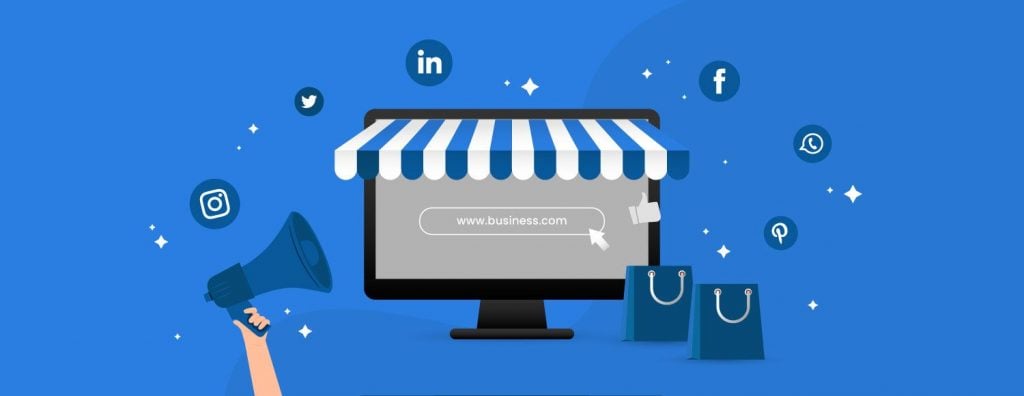In an era of cutting-edge technology, it’s no wonder that digitalisation is on the rise. With more than 2 billion people expected to shop online in 2021, it is more important than ever to have a strong digital presence – especially for small businesses to establish their brand.
A business’s main goal is obviously to attract new customers and retain existing ones. The best way to do this is through an effective digital marketing strategy.
How do we benefit from the advantages of digital marketing to drive traffic and customer retention? This article will explain the importance and benefits of digital marketing to grow a business. By understanding marketing goals, we can craft a digital marketing strategy that suits the nature of the business and its audience. Keep in mind that all businesses are unique, hence, there isn’t a one-solution-fits-all strategy and strategies evolve over time.
To see results, it’s important to be patient and consistently follow the strategy. Over time, one can better examine analytics and test campaigns to learn what works best for that particular business. Ultimately, if applied correctly, businesses can expect to see important metrics increase – whether it be sales, qualified leads, or higher traffic!
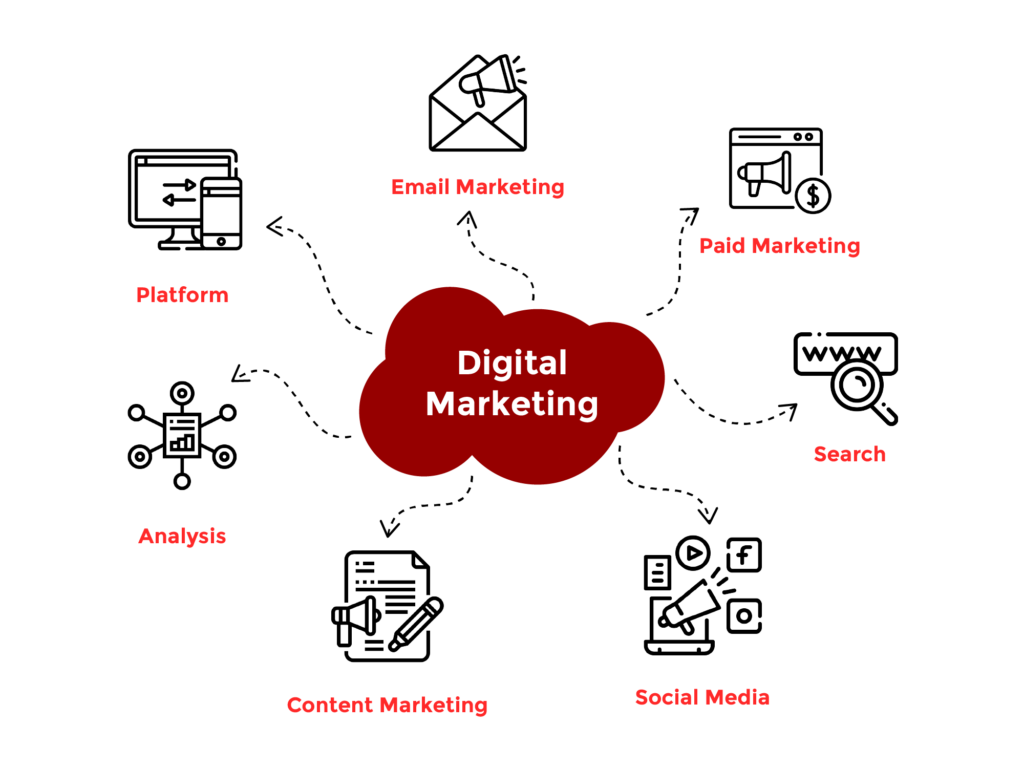
Define Your Goal
When running a successful marketing campaign, ensuring a proper marketing funnel is the highest priority. Essentially, a marketing funnel is a way of breaking down a customer’s journey. From a potential customer becoming aware of your brand to considering a purchase, and finally, purchasing it.
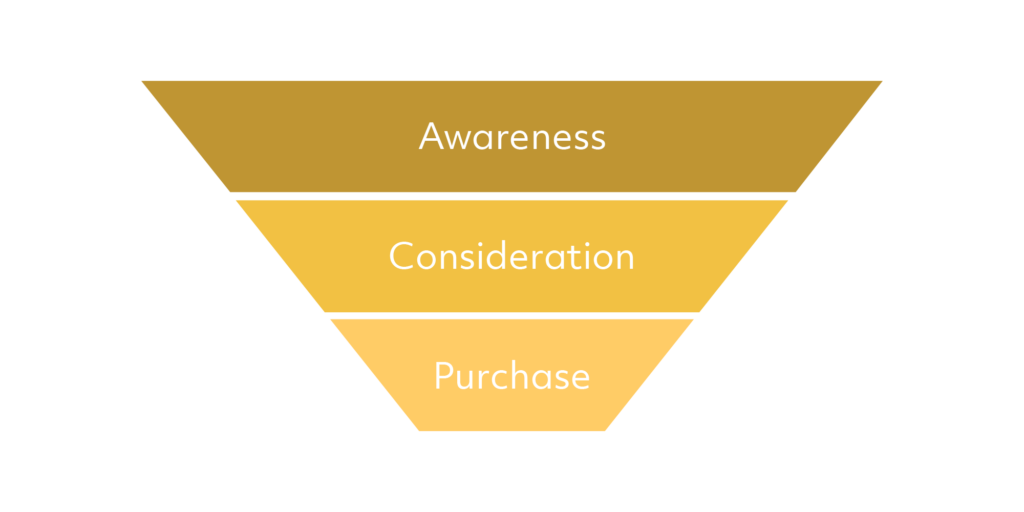
Customers are the most important asset of any business. Understanding where customers are in the marketing funnel can assist in defining goals. Through understanding the customer journey, marketing strategists can define which digital platforms and strategies to move forward with.
For instance, new businesses generally want to target new customers to sell products or services to. In that case, the primary marketing goal is in the awareness stage. Prospecting ads on Facebook or Instagram can help drive brand awareness and reach new potential customers.
It’s important to clearly define marketing goals before coming up with a strategy in order to pinpoint exactly which digital channels and platforms are most effective and advantageous to use.
One of the most important things to understand is not to commit too heavily to only one strategy and instead be prepared to tweak and change as more data and information is gathered. For example, say a company has allocated 50% of their marketing budget to Google and the other 50% to Facebook. After two weeks or so, the company is gaining far more leads or sales from Facebook compared to Google. At this stage, it’s important to quickly increase budget allocation from Google to Facebook in order to achieve greater conversion. Stubbornly sticking to the 50%/50% distribution model, in this case, would lead to lower metrics in the short term.
Benefits of Digital Advertising
It’s no surprise that digital marketing is becoming more popular by the day. Due to high-speed internet and the increase in mobile usage, people are now able to buy anything they want wherever they are. To reach these consumers, undoubtedly digital marketing is the way forward. Here’s why businesses should take advantage of it:
Cost-Effective
There’s a misconception that in order to do great marketing, spending more money helps. That’s not always the case because even if an ad reaches a million people, it’s unlikely marketing goals will be achieved without a well-planned and researched content strategy.
So, for small business with small marketing budgets, transitioning to a digital marketing model could save more (as much as 40%) compared to traditional marketing channels.
There are numerous free ways to digitally market a business, such as posting a range of organic posts on Facebook and Instagram. These platforms have hundreds of millions of users and therefore it’s easier to reach the intended audience.
Besides, with the fast-paced advancement of technology, traditional marketing channels such as TV, radio, and magazines are most likely being replaced by digital channels such as Facebook, YouTube, and other streaming services.
Fast and Flexible
During the days of traditional marketing, planning a billboard ad could require 2-3 months from planning to execution. With digital marketing, we have the opportunity to do more things and at a quicker pace. For instance, a last-minute campaign is much quicker to set up as a digital campaign, as the ads can be ready within a few hours. By nature, traditional outlets do not have the same opportunity.
A digital campaign is also very flexible. It gives marketers the option to make quick changes anytime and anywhere if the need arises. For a small business, this could be beneficial when trying to scale over time.
Easy to Track
How do performance marketers track an ad campaigns effectiveness? While it can be difficult to track if your ad is performing on traditional media such as TV or radio – every digital marketing technique used is measurable. On top of that, performance marketers can quickly adjust or pause the campaigns that are not working and increase the spending on the ones that do.
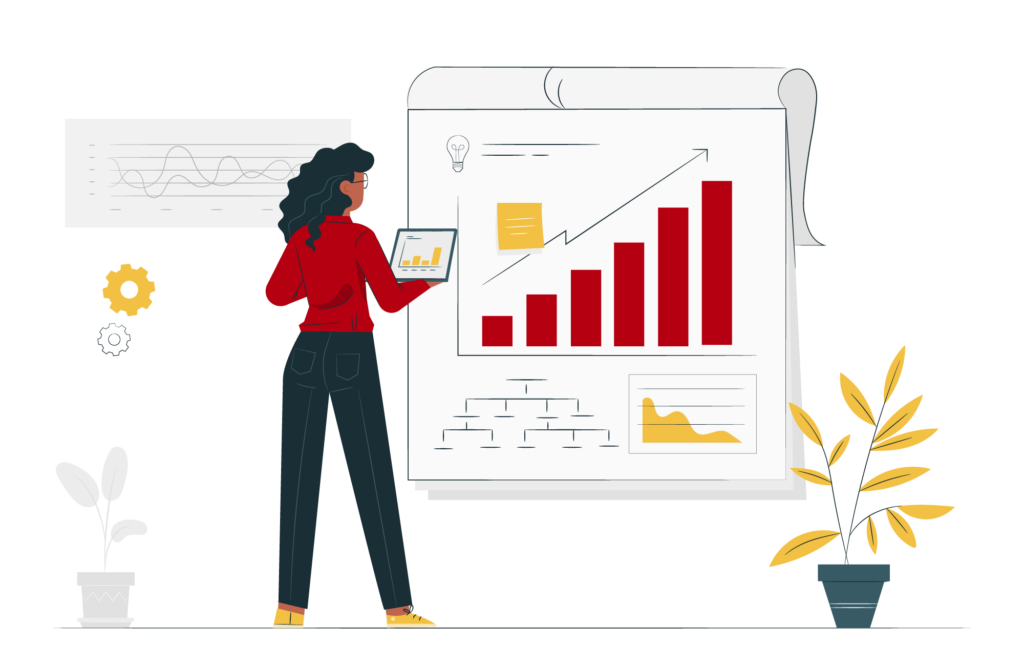
With the right tracking tools and pixel setup, they are able to check which marketing channel is performing the best for their campaign. This not only gives them an advantage in understanding their customer’s purchase behavior but also allows them to retarget their audience in the right channel and in the most relevant way. Digital marketing eliminates the guesswork when it comes to marketing and content strategy
Know Your Customers
One of the best features of digital marketing is the ability to target specific audiences – especially with tracking tools such as Google Analytics and Facebook Pixels. It helps performance marketers identify and target people who are interested in their products and leave out the rest.
Once uninterested people are eliminated from the equation, a proper ad budget can then be derived. In comparison, traditional media forces you to spend money displaying ads to people who may or may not be interested at all in your product or services.
A great alternative to learn more about your brand’s customers is by engaging with them. Here you can create interactive posts such as polls or questionnaires on Instagram stories, or run a contest or two on Facebook to see how your customers react. All these initiatives will allow you to analyse your customer’s behaviour and interest via your social platforms.
Examples of Digital Advertising Channels
Now that we have established the importance of digital marketing strategies, and the benefits it brings, let’s take a look at the different ways of utilising these great marketing channels.
Organic: SEO (Search Engine Optimisation)
Here’s a tip. When it comes to website visibility, always aim to rank on top of a search engine page (preferably the top 3 results) because 75% will never scroll past the first page on Google. This can be a huge value for a business as it will give them the opportunity to gain more brand awareness, website traffic, and potential sales.
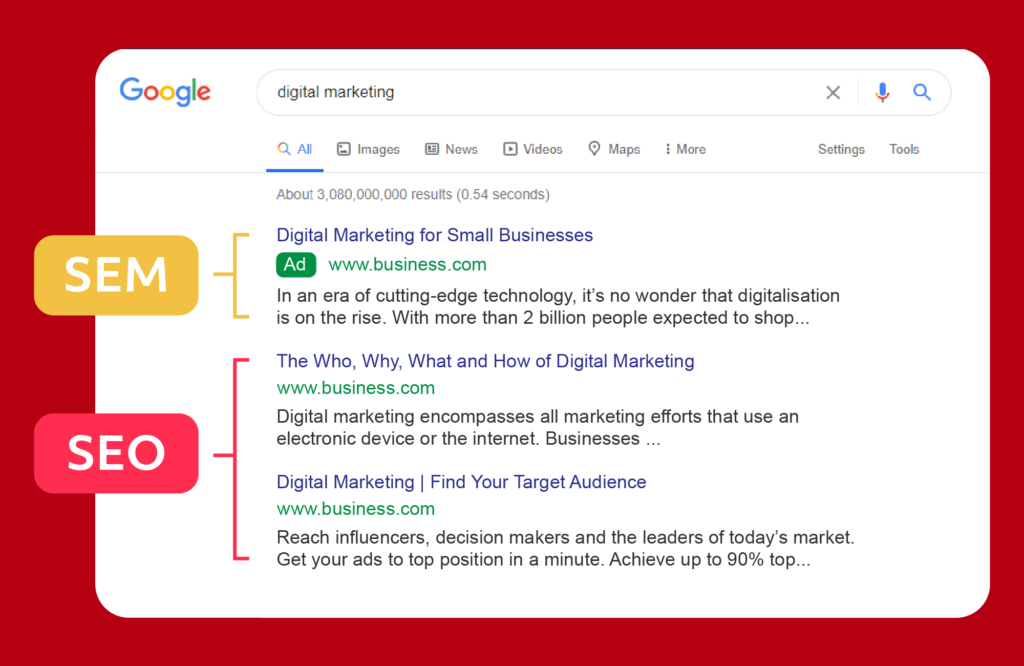
So how does a site reach the top of a search page?
Here’s when the Search Engine Optimisation becomes useful. The best part? It’s free! To achieve great results of SEO, performance marketers need to identify the right keywords to use while keeping the meta title and description relevant to the brand. We’ve written an entire blog post of how you can do it here.
Paid Marketing
Paid advertising is a great way to reach a broader audience that is not possible to reach through organic marketing. Don’t worry, any brand can achieve great results even with a small budget.
When talking about paid advertising the main marketing platforms are Google and Facebook. Paid advertising on Facebook includes boosting an organic post, run page like ads, or generic ads – all of this to reach new potential customers. Paid advertising for Google on the other hand allows a website to show up on top of the paid search engine results for keywords that people are searching for.
Working with both channels can be a great way of moving customers along the marketing funnel. Facebook is especially great for top-of-the-funnel marketing if the marketing goal is to create awareness for a brand. Whereas Google gives brands the opportunity to convert customers further down the funnel as they have a higher search intent.
For example, let’s say you have a clothing store. To build awareness for your brand, you may run prospecting ads targeting people who are interested in fashion or design on Facebook. When there’s enough awareness for your brand, customers who are interested in your brand will search you for you on Google to get to learn more about your product and services through your store’s website and potentially make a purchase!
CRM or Email Marketing
Email marketing is not dead. In fact, it is one of the many digital platforms that can allow brands to stay connected with their audience on a deeper, much more personal level. Look at emails as a love letter from the brand to its customers.
To build a proper audience list, it’s important to first acquire data and this can be done through marketing platforms. For instance, running a Facebook and Instagram lead generation ad or offering a reward in exchange for their email address on the brand’s website such as a “20% off your first purchase, sign-up now!” banner.
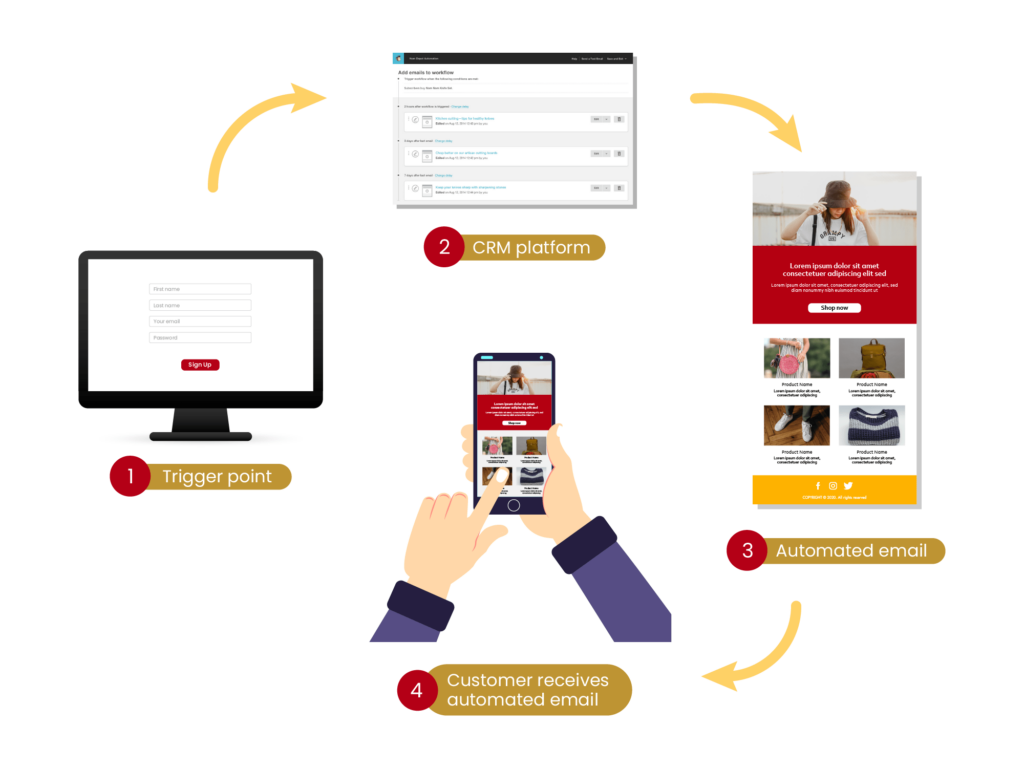
Next, consider building an automated email flow. Automated email flows send emails automatically as long as there’s a trigger action. For instance, if someone signs up on a website, this can be considered a trigger action. What happens next is that the CRM platform will send an automated ‘Welcome’ email that was pre-built, to the customer. These automated emails do not have to be complicated, because even if it’s just a simple email saying “Thank you for subscribing. We can’t wait to update you on promos, news, and more!”, at least it’s letting them know that they are valued. Doing so makes each customer feel valued as an individual and also helps build a trustworthy relationship with them.
Social Media
Social media is one of the most crucial marketing platforms to tap on. With the ever-increasing usage of mobile devices, almost everyone has a Facebook or Instagram account. Facebook messenger or Instagram direct message is typically where customers go if they’ve queries about a brand’s product and services.
Hence, it’s important especially for small businesses to have a social media presence so that the audience is aware of the brand’s existence on platforms they’re familiar with. This allows customers to reach out to these brands conveniently. Plus, owning a Facebook or Instagram account is free!
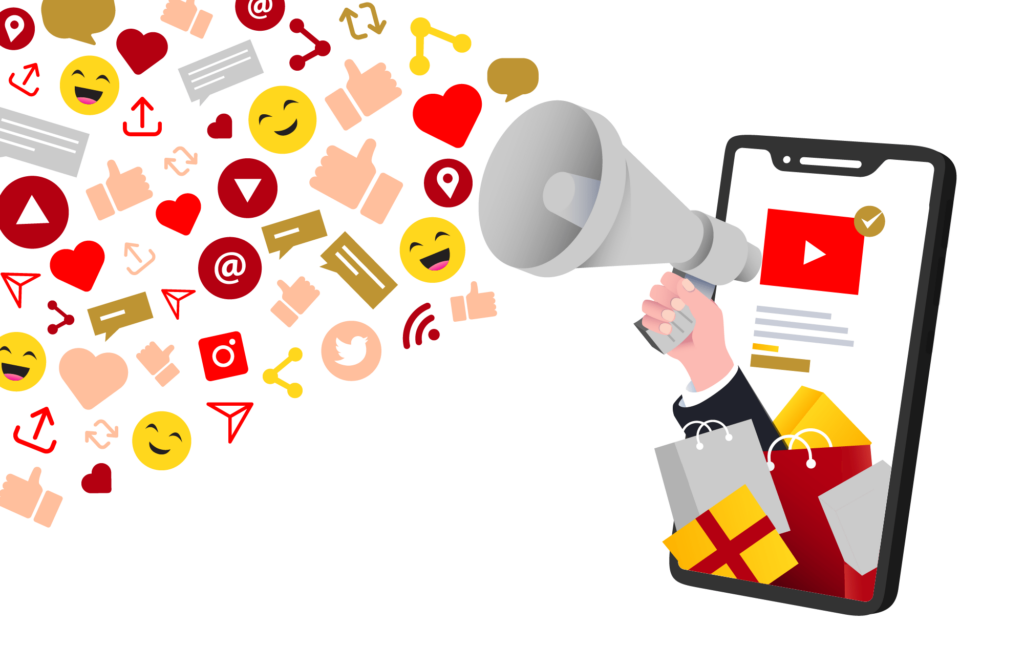
However, keep in mind that it is important to understand which social platforms the brand’s intended audience uses the most, that way it’s easy to reach out to them and build awareness. We would also recommend combining social media activities with paid ads as it will accelerate audience reach and help the brand grow faster.
Content Marketing
They say “Content is King” and this still holds to be true. No matter the size of a business, a good content strategy is a tried and tested way to engage customers. Keep in mind though that great content isn’t about how good the designs are and neither is it the fancy words in the copy. Great content is all about relevancy.
For instance, if a skincare brand wants to promote a new range of products for dry skin, the content should be catered to address dry skin issues and how the brand’s product can help. This creates value and relevance.
On the other hand, if the product is being promoted generically without any promotion of the product itself or which skin type it is for, chances are that ad won’t gain much traction. By creating relevant content, not only does the brand connect with its audience better, but it also creates a sense of authority and credibility.
Now that the importance of creating relevant content has been established, it should also be known that content consistency is equally crucial. This includes ad creatives, copy tonality, and all things that build a brand’s identity.
When content is consistent, it shows audiences that the brand understands its own products and services well. It shows that everything was thought of properly from social media presence to website flow. This impression helps build a trusting relationship between brand and customer, and that usually leads to higher traffic and higher conversions!
If you’re interested in digital marketing strategies, we offer solutions that can boost your company’s sales. Drop us a note at hello@admiral.digital and let’s schedule a chat!
